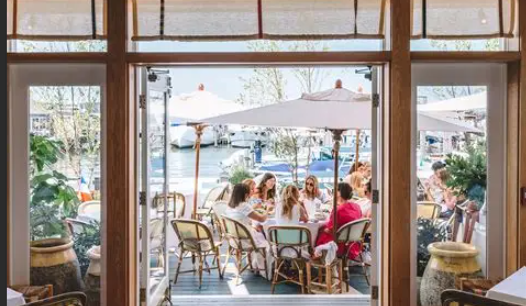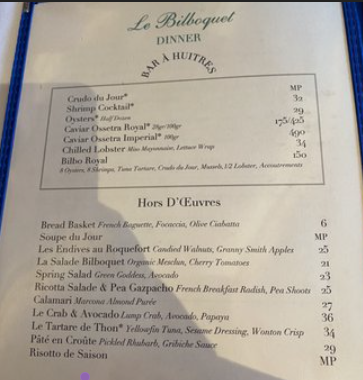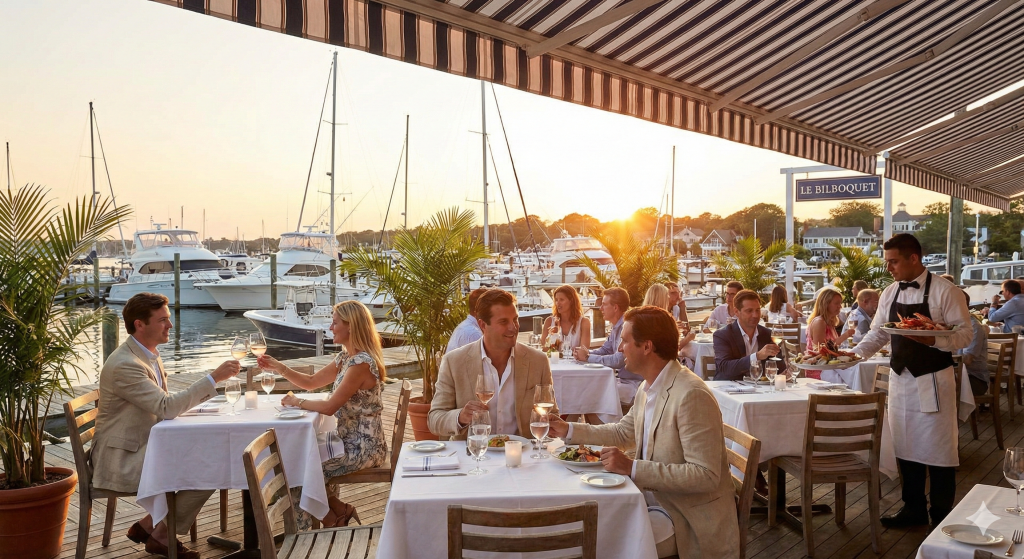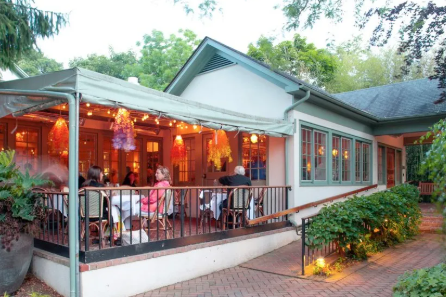The Hamptons’ Best-Kept Secret Restaurant
The yacht has docked. The rosé is chilled. And somewhere along Long Wharf, a table awaits that will make or break your Hamptons summer. Le Bilboquet Sag Harbor operates under a deceptively simple premise: transport the Upper East Side’s most coveted dining room to a marina overlooking bobbing sailboats and transform every meal into a celebration. What began as a 35-seat Manhattan institution in 1986 has evolved into a global phenomenon, yet the Sag Harbor outpost retains something the others cannot replicate—waterfront magic that makes St. Tropez feel like a reasonable comparison.
Philippe Delgrange opened the original Le Bilboquet on East 63rd Street with barely 450 square feet and no liquor license. He biked wine from the nearest liquor store. He invented dishes based on whatever occupied his microscopic kitchen. One serendipitous creation—the now-legendary Cajun Chicken—emerged from necessity and became the signature that defines the brand nearly four decades later. Today, with partners including Eric Clapton, Ron Perelman, and Steven Witkoff, the empire spans New York, Palm Beach, Atlanta, Dallas, and Denver. But insiders know: Sag Harbor hits different.
Why Le Bilboquet Sag Harbor Captured the Hamptons
When the restaurant opened in 2017, it occupied the former B. Smith space on Long Wharf. Practically overnight, the address transformed into the East End’s most electrifying social hub. Tom Brady, Emily Blunt, Hugh Jackman, and Amber Heard have all been spotted at tables overlooking the marina. The celebrity magnetism matters less than what it signals: this is where people who can dine anywhere choose to dine.

The location itself operates as an unfair advantage. Sag Harbor’s whaling village charm provides authentic character that money cannot manufacture. Yachts bob in the background. Sunsets paint the sky in colors that complement the rosé. The horseshoe-shaped bar generates energy that spills onto the waterfront terrace, where late-night DJs spin while guests who arrived for dinner find themselves still dancing at midnight.
The French Bistro Formula Perfected
According to McKinsey’s State of Tourism and Hospitality research, demand for luxury tourism and hospitality grows faster than any other travel segment. Consumers increasingly prioritize experiences over possessions. Le Bilboquet understood this trajectory decades before consultants quantified it. The restaurant sells atmosphere as much as food—belonging as much as sustenance.
Research from Tastewise on luxury food trends reveals that 72% of consumers desire more experiential dining encounters. Le Bilboquet delivers exactly this. You’re not merely ordering Cajun Chicken; you’re participating in a ritual that connects you to four decades of Manhattan social history, transplanted to a harbor that once built whaling ships.
The Menu That Built an Empire
The Poulet Cajun deserves its reputation. Philippe Delgrange’s original recipe—a closely guarded blend of spices applied to perfectly cooked chicken—arrives with crispy pommes frites and green salad. The combination seems almost too simple to warrant obsession. Yet regulars order nothing else, meal after meal, summer after summer. Some dishes transcend innovation; they achieve inevitability.

The tuna tartare demonstrates equal mastery. Fresh, precisely cut, seasoned with restraint that allows quality to speak. The crab and avocado salad has graced the menu since the Manhattan days, proving that perfection requires no reinvention. Dover sole arrives from Brittany, a commitment to sourcing that justifies premium pricing.
Beyond the Classics
Seasonal specials showcase the kitchen’s range without betraying its identity. La Burrata with grilled corn, peaches, and pistachios captures summer on a plate. Seared scallops at $59 represent splurge-worthy seafood. Le Bar à Huîtres presents oysters and shellfish towers that transform appetizers into events.
The cocktail program merits serious attention. The Harborview—gin, passionfruit, vanilla foam—balances refreshment with indulgence. Oh La La delivers watermelon and gin in a tall glass that photographs beautifully and drinks even better. Nuestra Dama brings jalapeño heat to tequila with a tajín rim for those seeking something with edge.
Understanding the Le Bilboquet Experience Economy
The global brasserie market reached $32.8 billion in 2024, according to industry research, with projected growth to $54.6 billion by 2033. This expansion reflects changing consumer preferences toward venues offering more than meals—they demand ambiance, social engagement, and memorable encounters. Le Bilboquet positioned itself at this intersection before the trend had a name.
Deloitte’s Future of Restaurants analysis emphasizes that restaurant companies face pressure to push beyond traditional boundaries and capture new revenue streams through innovative concepts. Le Bilboquet achieves this through what founder Delgrange calls “table hopping”—actively encouraging guests to move between conversations, transforming dinner into an ongoing social event rather than a static seated experience.
The Psychology of Belonging
Not everyone secures a table at Le Bilboquet. Delgrange acknowledges this reality without apology. The selectivity creates value precisely because it signals membership in something exclusive. Dress codes exist. Expectations apply. The restaurant cultivates atmosphere by curating clientele, a practice that polarizes observers but produces undeniable results.
For those granted entry, the experience delivers validation alongside cuisine. You belong here. You’re part of this. The grandparents brought their children, who now bring their children, creating generational loyalty that transcends any single meal. Delgrange understands this dynamic intuitively: “If you don’t take care of the grandparents and the grandchildren, you have no business.”
Philippe Delgrange: The Restaurateur as Conductor
Delgrange arrived in New York from Cambrai, France, at 18 years old. He worked in a perfume factory before discovering his calling in hospitality. The Atrium Club provided early training. Celebrity nightclub owner Regine refined his understanding of atmosphere. Le Relais on Madison Avenue taught him French fine dining. By 1986, he was ready to create something uniquely his own.
His uncle’s influence runs deeper than most realize. The L’Alliance New York recently honored Delgrange with its Art de Vivre Award, recognizing his embodiment of French cultural values in American hospitality. At just 14 years old, he began his restaurant career in France—so young that President Charles de Gaulle personally signed his work permit. That early discipline shaped everything that followed.
The Philosophy of Presence
Despite overseeing nine restaurants across multiple cities, Delgrange maintains visible presence at his establishments. He moves through dining rooms greeting guests, adjusting details, reading energy. “Years ago, people would have one restaurant and put all their love in one place,” he observes. “Now, if you have one, you are not doing that well. I am very old-fashioned—I like to go to my own space and see my clients and friends.”
This hands-on approach contradicts contemporary hospitality wisdom favoring corporate systematization. Yet it explains why Le Bilboquet maintains consistency that franchised concepts struggle to achieve. The founder’s eye catches what procedures miss. His relationships with regulars create loyalty that marketing cannot purchase.
What Makes the Sag Harbor Location Special
Manhattan’s East 60th Street flagship seats 120 and commands fierce competition for reservations. The Sag Harbor outpost operates with similar intensity during summer months, but the setting fundamentally alters the experience. Water changes everything. The marina view strips away urban urgency, replacing it with coastal ease that permits longer lingering.
The restaurant describes itself as “a home away from home” for Upper East Side regulars who followed their beloved bistro eastward. This framing captures something essential. Le Bilboquet Sag Harbor doesn’t compete with local restaurants; it imports Manhattan social infrastructure to summer territory, creating continuity for a clientele that expects familiar excellence wherever the season takes them.
Events and Private Dining
The waterfront setting enables weddings and large events impossible in urban spaces. Partial and full buyouts accommodate celebrations requiring exclusivity. The restaurant has hosted anniversary dinners, milestone birthdays, and corporate gatherings where the venue itself communicates achievement. Booking requests flow through dedicated event coordination, ensuring seamless execution for occasions demanding perfection.
Weekend brunch draws crowds seeking leisurely starts to Hamptons days. The scene skews younger, more casual, though standards remain unchanged. The transition from dinner elegance to daytime energy demonstrates operational flexibility that lesser establishments cannot manage.
Navigating Expectations and Realities
Le Bilboquet polarizes by design. The dress code—”elegant smart casual”—filters patrons seeking casual beachside dining. Prices sit firmly in special-occasion territory, with entrées commanding $40-60 and cocktails approaching $20. The experience justifies the investment for those seeking it; those expecting different fare should dine elsewhere.
Reviews reveal the polarization. Devotees describe transcendent evenings, exceptional service, irreplaceable atmosphere. Critics cite pricing, occasional service inconsistencies, or simply incompatibility with the cultivated vibe. Both perspectives contain truth. Le Bilboquet doesn’t attempt universal appeal; it serves a specific clientele with specific expectations.
Practical Considerations
The restaurant occupies 1 Long Wharf in Sag Harbor, directly on the marina. Reservations prove essential during summer months, particularly for waterfront seating at sunset. Weeknight dining offers slightly easier access than weekend peaks. The bar welcomes walk-ins seeking cocktails and lighter fare without full dinner commitment.
Hours extend through lunch and dinner service during season, with the bar maintaining energy late into evening. Off-season operations vary, so confirmation before arrival prevents disappointment. The location lacks significant parking; plan accordingly or embrace the village’s walkability.
Le Bilboquet Within the French Dining Renaissance
The French bistro concept has experienced remarkable global evolution. Taste of France Magazine documents how “La Bistronomie”—the fusion of bistro conviviality with haute cuisine technique—represents the most pivotal gastronomic movement in Western countries since 1945. Le Bilboquet anticipated this trajectory, delivering sophisticated food in accessible settings decades before the trend achieved formal recognition.
The model’s success spawned imitation but rarely replication. Atmosphere cannot be engineered through design alone; it requires years of cultivation, relationships spanning generations, and an owner whose presence transforms transactions into welcomes. These elements defy franchising, explaining why Le Bilboquet maintains distinctiveness despite expansion.
The Future of Dining Experiences
Younger consumers increasingly prioritize experiences over material acquisition. Gen Z treats dining as cultural currency, seeking venues that deliver shareable moments alongside quality cuisine. Le Bilboquet instinctively understood this dynamic before demographic research confirmed it. The restaurant has always been as much about being seen as about eating well—a proposition that gains rather than loses relevance as social media amplifies visibility.
Sustainability of this model requires continuous evolution without betraying core identity. Delgrange navigates this tension by maintaining what works while reading contemporary currents. The food remains classically French. The atmosphere permits modern expression. The balance sustains relevance across changing seasons and shifting tastes.
Discover the Hamptons’ Most Coveted Table
Le Bilboquet Sag Harbor transcends restaurant classification. It functions as social infrastructure for a community that expects excellence and rewards loyalty. The Cajun Chicken alone merits pilgrimage; the setting transforms meals into memories; the atmosphere creates connections that outlast any single evening.
For those seeking the Hamptons’ best-kept secret restaurant, the secret has been hiding in plain sight—at a waterfront table overlooking yachts, with rosé sweating in the summer air and the hum of a crowd that knows exactly where they belong. Your reservation awaits. The question is whether you’re ready to claim it.
Connect With Social Life Magazine
Feature Article Ideas / Advertising / Brand Partnership Inquiries
→ Contact Social Life Magazine
Polo Hamptons Tickets, Cabanas & Brand Sponsorships
→ Polo Hamptons
Join Our Email List
→ Subscribe Here
Social Life Magazine Print Subscription
→ Get Your Subscription
Support Our Work – Donate $5
→ Donate via PayPal







